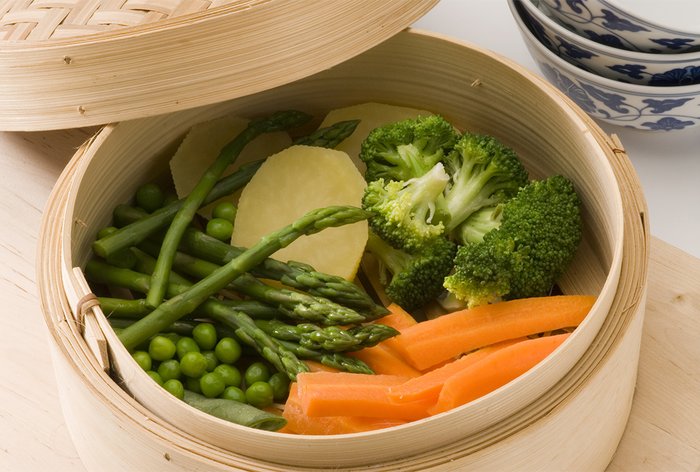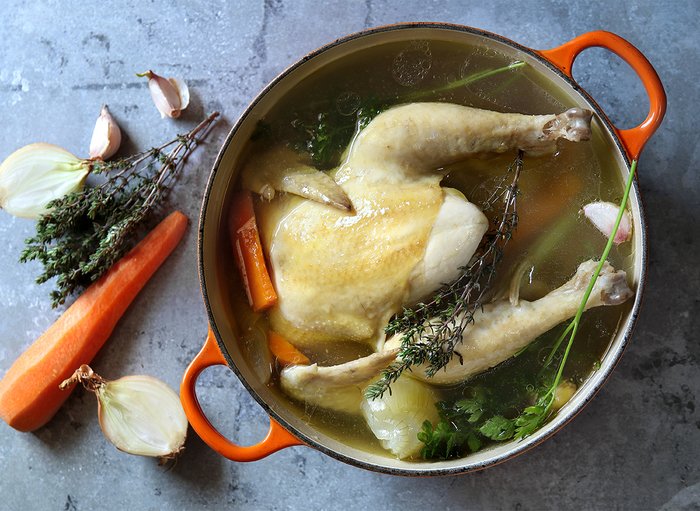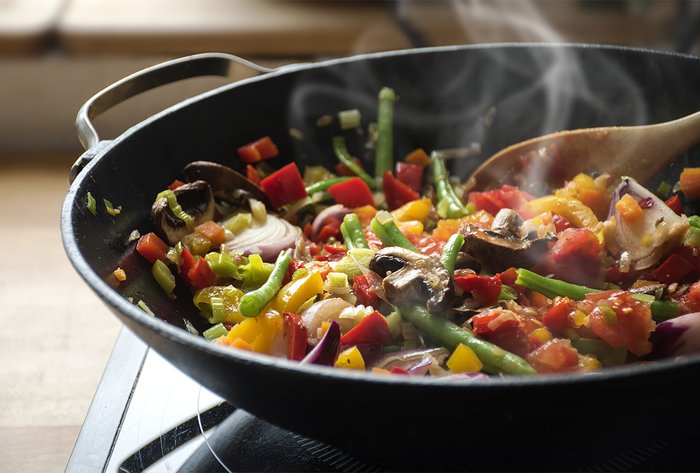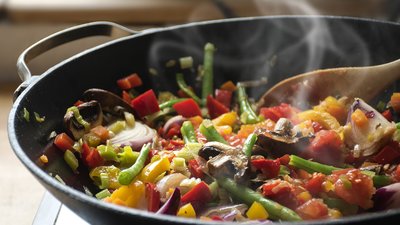Anybody can toss a burger on the grill or stick a meal in the microwave, but if you want to keep things fresh by coming up with interesting new meals, why not use the full range of meal prep techniques? These three methods will improve the overall nutritional makeup of your diet, and you don't need to be a culinary whiz to pull them off!
Steaming Is Perfect For Delicate Meats
For centuries, cultures around the globe have been cooking food with steam. Suspend almost any meat, vegetable, or fruit in a basket or tray over simmering water and you can prepare foods simply and cleanly.
Unlike boiling, which can leach water-soluble nutrients such as vitamin C and folate from vegetables, steaming helps retain them. When foods are properly steamed, they also retain their moistness, texture, flavor, color, and, in some vegetables, valuable disease-fighting antioxidants.[1,2,3]
Steaming tends to help lean meats like chicken breast and fish retain their moisture instead of being dried out by frying or grilling. And since you don't need oil to steam, you can shave extra calories from your meal.

How to steam: To use a steamer, fill the base with a few inches of water, place the steaming tray or trays filled with food on top of the pot, secure the top lid, bring the water to a boil, then reduce heat and let the food steam until fully cooked. Use an instant-read food thermometer to determine when meats are ready.
To ensure each food receives the appropriate amount of heat, place meats and hearty vegetables closest to the steam and the more delicate items, like greens, farther away. Use parchment paper or large greens like Napa cabbage to limit sticking. Don't try to steam too much food at once, and don't allow the food to sit in liquid as it cooks.
Tools of the trade: Inexpensive and durable, old-school bamboo steamers are a nice break from all the metal and silicone found in modern kitchens. With stackable trays, these steamers allow you to cook multiple parts of a meal at the same time, getting food to the table faster and simplifying cleanup. They can be a bit harder to clean, though, and can take on the smell of certain foods. Collapsible or flexible metal or silicone steamers that fit inside pots work, too, as will electric steamers.
What to watch out for: It isn't unusual for vegetables to get over steamed and end up with a mushy texture and no taste, so keep an eye on them as they cook. If you do steam a vegetable for too long, quickly plunge it into a bowl of ice water to interrupt the cooking process. Don't let the steamer run out of fluid or you can ruin it. And remember: Steam is hot! Be careful when opening the steamer trays.
Poaching Keeps Proteins Moist
Like steaming, poaching is also an excellent way to prepare delicate meats such as boneless, skinless poultry breasts or thighs, pork loin, and fish fillets—even some fruits—that are prone to being overcooked when prepared using other methods. Poach a chicken breast, fillet of salmon, or a pear and you'll never again want to dry them out with grilling. Many people claim that a poached egg is the best egg you'll ever eat.
Like steaming, poaching requires no calorie-filled oils, is splatter free, and delivers a wonderful extra benefit: the poaching liquid itself. By adding soup stock, wine, beer, cider, coconut milk, or tomato sauce to the poaching liquid, you can create delicious bases to use in other recipes. Add onions, celery, lemon slices, curry paste, ginger, spices, and herbs to the liquid for extra flavor.
Another benefit of poaching is that it doesn't produce the advanced glycation end products (AGEs) that can come with searing meats at high temperatures. AGEs are thought to contribute to the inflammation in the body associated with maladies like heart disease and cancer.[4]

How to poach: Place your food in a pot large enough for it to fit in the pan in one layer. Add liquid to completely cover the food by about one inch. Bring the liquid to a low simmer so that only an occasional bubble breaks the surface. Partly cover the pot and continue poaching until your meat is cooked through, periodically skimming off any foam that accumulates on the top of the liquid.
A four-pound whole chicken takes about 45 minutes to poach and can provide you with a week's worth of meat. Chicken breasts take about 15 minutes to poach, while a skinless salmon fillet can take about 8 minutes.
Tools of the trade: Enameled cast iron or stainless steel pots work great for poaching. The amount of food you want to poach determines the size of the pot. For best results, use a pot that limits the amount of room for extra liquid. Purchase long, slender pans for poaching fish.
What to watch out for: Unlike when you steam, never bring poaching liquid to a boil. This will dissolve fats into the liquid and give the food a greasy quality. As with steaming, be careful not to overcook the food.
Stir-Fry for Crisp Veggies
Stir-frying involves cooking meats and vegetables at a very high heat for a very short time. Short, rapid cooking reduces the time from stove to plate and, because you only use one pan, there is less cleanup. Stir-frying can help retain more nutrients, as well as flavor, texture, and color.
Stir-frying is a great way to bring more vegetables into your diet, since most recipes call for generous amount of vegetables, from carrots and mushrooms to water chestnuts, bean sprouts, broccoli, and bok choy.

How to stir-fry: Ideally, use a round-bottomed wok pan designed to quickly brown the food in the belly of the pan, then move it up the sloping sides of the pan to cook more slowly.
Things happen quickly down in the belly, so make sure you have all the necessary ingredients cut and ready to go ahead of time. Slice your vegetables and meats into small, uniform pieces so they cook quickly and in the same amount of time.
Use only quick-cooking proteins including chicken breast, steak, shrimp, salmon, pork tenderloin, or tofu. Avoid tough cuts like pork shoulder that benefit from long, slow cooking. Also avoid delicate fish such as sole or flounder.
Preheat your wok or skillet over medium-high heat to get it very hot before adding the oil. Choose oils that have a high smoke point such as avocado, grapeseed, canola, rice bran, peanut, or safflower. Add oil to the wok, making sure to coat the slopes of the pan. Don't use too much oil—just enough to form a thin film on the pan.
Begin by cooking your meat. No more than a pound of raw meat should be placed in the pan at a time. Before tossing it around, let the meat or tofu sit in the pan undisturbed for a few moments so it can brown for better flavor. Once you've fully cooked the meat, remove it from pan and set aside.
To cook your vegetables, start with denser vegetables like carrots, zucchini, or asparagus. Once they're cooked, push them up the side of the wok and add more delicate ingredients such as leafy greens, peas, and even fruits like cubed mango.
Constantly stir and flip the vegetables to prevent them from burning. Once the vegetables are just tender-crisp, return your protein source along with any seasonings or sauces and cook for roughly another minute to blend the flavors.
Tools of the trade: The size of the pan you'll need depends on the number of people you're feeding. A good, middle-of-the-road choice is a 14-inch-wide wok with a depth of at least 4 inches. This size prevents oil from splattering and allows for plenty of food to be cooked at the same time.
An inexpensive carbon steel wok with a wooden handle will get the job done. Over time and with careful cleaning, a steel wok can develop a natural non-stick surface that reduces the amount of oil needed to prepare a meal. A flat-bottomed wok can sit directly on a stovetop burner. You need an adapter ring to use a traditional round-bottomed wok.
You can also stir-fry in a skillet, but make sure to use one that has high sides so that the food and the oil stays inside the pan.
What to watch out for: Many people test the temperature of the wok by sprinkling a few drops of water into it. When the water droplets vaporize on impact, it's time to add your oil. Just be careful not to mix more than a few drops of water in hot oil because it can cause a reaction that sends droplets of hot oil in all directions. Be careful to pat dry your vegetables before you add them to the pan to avoid this.
References
- Preti, R., Rapa, M., & Vinci, G. (2017). Effect of Steaming and Boiling on the Antioxidant Properties and Biogenic Amines Content in Green Bean (Phaseolus vulgaris) Varieties of Different Colours. Journal of Food Quality, 2017.
- Dolinsky, M., Agostinho, C., Ribeiro, D., Rocha, G. D. S., Barroso, S. G., Ferreira, D., ... & Fialho, E. (2016). Effect of different cooking methods on the polyphenol concentration and antioxidant capacity of selected vegetables. Journal of Culinary Science and Technology, 14(1), 1-12.
- Murador, D., Braqa, A. R., Da Cunha, D., & de Rosso, V. (2016). Alterations in phenolic compound levels and antioxidant activity in response to cooking technique effects: A meta-analytic investigation. Critical Reviews in Food Science and Nutrition, (just-accepted), 00-00.
- Uribarri, J., Woodruff, S., Goodman, S., Cai, W., Chen, X., Pyzik, R., ... & Vlassara, H. (2010). Advanced glycation end products in foods and a practical guide to their reduction in the diet. Journal of the American Dietetic Association, 110(6), 911-916.



